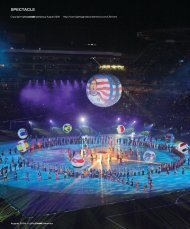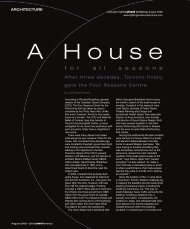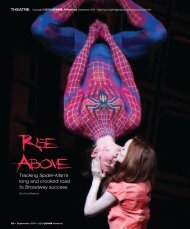Color control of LED luminaires By RobeRt bell - Lighting & Sound ...
Color control of LED luminaires By RobeRt bell - Lighting & Sound ...
Color control of LED luminaires By RobeRt bell - Lighting & Sound ...
You also want an ePaper? Increase the reach of your titles
YUMPU automatically turns print PDFs into web optimized ePapers that Google loves.
<strong>Color</strong> <strong>control</strong> <strong>of</strong> <strong>LED</strong> <strong>luminaires</strong> <strong>By</strong><br />
Why it is not as easy as you might think.<br />
Robert Bell<br />
A bit about additive<br />
color mixing<br />
With recent mass acceptance<br />
<strong>of</strong> solid-state <strong>LED</strong> lighting, it’s time<br />
for an explanation <strong>of</strong> this technology’s<br />
complexities and ways in which it can be<br />
tamed. <strong>LED</strong> <strong>luminaires</strong> use the output <strong>of</strong><br />
multiple sources to achieve different colors<br />
and intensities. Additive color mixing is<br />
nothing new to our industry. We’ve done<br />
it for years on cycloramas with gelled<br />
<strong>luminaires</strong> hitting the same surface, but<br />
<strong>control</strong> can be tricky. The first intelligent<br />
luminaire I used was a spotlight that had<br />
three MR16 lamps, fitted with red, green,<br />
and blue filters. In the early days, the <strong>control</strong><br />
<strong>of</strong> <strong>luminaires</strong> such as these was simply three<br />
DMX512 <strong>control</strong> channels and no single<br />
intensity <strong>control</strong> channel. You could not<br />
easily roll down the brightness and keep the<br />
color. Typically, moving light programmers<br />
would also build a “color black” so they<br />
could easily turn <strong>of</strong>f these <strong>luminaires</strong>. There<br />
are better ways.<br />
Control and<br />
definition <strong>of</strong> color<br />
If you don’t <strong>control</strong> your intelligent<br />
<strong>luminaires</strong> using pure DMX levels but<br />
instead use some form <strong>of</strong> abstract <strong>control</strong>,<br />
you can have a virtual intensity level.<br />
So, even if the manufacturer defined the<br />
luminaire to use three DMX channels,<br />
abstract <strong>control</strong> allocates four handles<br />
to <strong>control</strong> it: intensity and three color<br />
parameters. Note I wrote “three color<br />
parameters” rather than red, green, and<br />
blue. RGB is just one way to describe color.<br />
Another description is by hue, saturation,<br />
and luminance, HSL. (Some say “intensity”<br />
or “lightness” instead <strong>of</strong> “luminance.”)<br />
Equally valid is hue, saturation, and value,<br />
HSV. Value is sometimes referred to as<br />
brightness and is similar to luminance.<br />
However, saturation in HSL and HSV differ<br />
dramatically. For simplicity, I define hue<br />
as color and saturation as the amount <strong>of</strong><br />
color. I also try to remember if “L” is set to<br />
100%, that is white, 0% is black, and 50%<br />
is pure color when saturation is 100%. As<br />
for “V”, 0% is black and 100% is pure color,<br />
and the saturation value has to make up the<br />
difference. That over simplifies it, but let’s<br />
carry on, as we’re not done yet.<br />
Another valid description <strong>of</strong> what comes<br />
out <strong>of</strong> a luminaire can be described by<br />
CMY (cyan, magenta, yellow), which are<br />
the primaries used with subtractive color<br />
mixing. If you start with white light, you<br />
introduce two filters to get red: magenta to<br />
remove the green component <strong>of</strong> the white<br />
light and yellow to remove the blue. <strong>Color</strong>changing<br />
<strong>LED</strong> <strong>luminaires</strong> in general do not<br />
use subtractive color mixing, but this is still<br />
a valid way to describe a color.<br />
Ideally, when <strong>control</strong>ling <strong>LED</strong>s, you<br />
should have the choice <strong>of</strong> adjusting intensity<br />
and one <strong>of</strong> RGB, CMY, HSL, or HSV. There<br />
are some variations on these themes to<br />
come, but let’s move on.<br />
Mixing color with <strong>LED</strong>s<br />
Our eyes can detect light from 390 to 700<br />
nanometers. The first <strong>LED</strong> <strong>luminaires</strong> used<br />
just red (about 630 nm), green (about<br />
540 nm), and blue (about 470 nm) <strong>LED</strong>s.<br />
Contrary to what your grade school art<br />
teacher said, mixing those three colors does<br />
not create every color your eye can see. Below<br />
is a hypothetical locus <strong>of</strong> an RGB system<br />
rendered on the entire visible light spectrum.<br />
Figure 1<br />
The triangle’s vertices hover around deep<br />
saturated reds, greens, and blues. Altering<br />
the power supplied to each <strong>LED</strong> die should<br />
allow you to reach any color inside <strong>of</strong> the<br />
gamut area, but this is theoretical, and many<br />
factors affect what really happens. Foremost,<br />
the exact wavelength <strong>of</strong> the R, G, and B can<br />
vary drastically from luminaire to luminaire.<br />
The locus <strong>of</strong> a color can just about<br />
describe hue but not intensity nor<br />
saturation. If you do a quick Google search<br />
on “color gamut,” you will see circles,<br />
donuts, cubes, cones, and even fruit, all<br />
attempting to show the three-dimensional<br />
relationships <strong>of</strong> HSL.<br />
Adding more<br />
colors at the source<br />
As <strong>LED</strong> technology evolved, prices dropped<br />
and various intellectual property lawsuits<br />
subsided allowing more companies to enter<br />
summer 2013<br />
28<br />
summer 2013
the market. <strong>Lighting</strong> designers’ appetites<br />
for this new light source grew and along<br />
with that came demand for brighter<br />
<strong>luminaires</strong> and more consistent color<br />
<strong>control</strong>. New <strong>LED</strong> colors became available<br />
too: white, amber, cyan, and violet. Initially,<br />
the most popular integration was RGBA,<br />
with an added amber chip. This made the<br />
color gamut that was sort <strong>of</strong> triangular<br />
more rectangular.<br />
Figure 2<br />
Another variation is RGBW, with broadspectrum<br />
white <strong>LED</strong>s. Luminaires exist that<br />
use white and amber with the three other<br />
colors (RGBAW).<br />
As <strong>LED</strong> technology continued to advance,<br />
chip manufactures managed to make deep<br />
red, cyan, and royal blue <strong>LED</strong>s, too. These<br />
have been used in seven-color systems (deep<br />
red, red, amber, green, cyan, blue, and royal<br />
blue). This enlarges the gamut, giving us<br />
potentially more colors.<br />
Figure 3<br />
Controlling this many chips can be<br />
tricky; for any one hue there are multiple<br />
combinations <strong>of</strong> power to each chip that can<br />
get you to that one point in the color space.<br />
What to do with<br />
all these <strong>LED</strong>s<br />
This is becoming a lot more complex than<br />
turning a light on and <strong>of</strong>f. Luckily, some<br />
modern <strong>control</strong> systems allow you to drive<br />
any type <strong>of</strong> color system in very simple<br />
ways. Apart from intensity you are <strong>of</strong>fered<br />
just three distinct color parameters: RGB,<br />
CMY, HSL, and HSV.<br />
Using a real-world example, let’s<br />
examine the possibilities. Say we’re doing<br />
a musical and we’re lighting the cyc with<br />
color mixing <strong>luminaires</strong>. We’re doing a<br />
sunset scene, and the designer wants a<br />
transition from amber to pink. Using the<br />
RGB color space, cue 1 is amber (R=100%<br />
G=60%, B=0%) and cue 2 is pink<br />
(R=100% G=0%, B=60%).<br />
Figure 4<br />
On any lighting console that defines color<br />
as RGB, the transition you see in Figure 4<br />
is exactly what you get. It is a straight line<br />
from amber to pink going through a slightly<br />
less vivid color <strong>of</strong> red. I write “slightly less<br />
vivid” because, in this case, the distance<br />
from the center <strong>of</strong> the wheel represents the<br />
saturation <strong>of</strong> the color and the mid-point<br />
on the line between the two end-points<br />
is closer to the center <strong>of</strong> the circle. Now<br />
imagine a transition from pink to green. In<br />
this model, moving in a straight line takes<br />
you right through white. This may or may<br />
not be desirable.<br />
You may describe the two cues slightly<br />
differently. In the example in Figure 5,<br />
the two end points are exactly the same:<br />
amber and pink. But in this case, the<br />
colors are represented using HSL. Cue 1 is<br />
amber with a hue <strong>of</strong> 10% (percent being<br />
an arbitrary unit for hue), and cue 2 is<br />
pink with a hue <strong>of</strong> 90%. Note that if you<br />
go counter-clockwise from amber, you<br />
reach red.<br />
Figure 5<br />
The transition is from amber to pink,<br />
but in this case, you pass through a red<br />
that has the same saturation as the two end<br />
points because it is equidistant from the<br />
center <strong>of</strong> the circle. We move in an arc, not<br />
a straight line.<br />
What if the color space were defined<br />
differently Say, it was mirrored so that<br />
when you were on amber and you moved<br />
counter-clockwise on the wheel, you<br />
would first reach yellow instead <strong>of</strong> red. In<br />
fact, you’d have to go a long way before<br />
you reached red. In Figure 6, cue 1 is<br />
again in amber (hue' <strong>of</strong> 10%) and cue 2<br />
is pink (hue' <strong>of</strong> 90%). These are the same<br />
values; they just appear at a different place<br />
in space.<br />
29<br />
PROTOCOL<br />
summer 2013
Figure 6<br />
As these are purely hypothetical color<br />
spaces (and we’re running out <strong>of</strong> letters),<br />
we’ve dubbed this the prime version <strong>of</strong> HSL,<br />
HSL'. If you read carefully above, you will<br />
see that amber was defined having a hue'<br />
<strong>of</strong> 10%. The ' after the triplet defines the<br />
mirror image <strong>of</strong> the color wheel. Regardless<br />
<strong>of</strong> your luminaire’s primary color system<br />
(RGB, RGBA, RGBW, or RGBAW), it’s<br />
possible to write cues and do transition in<br />
multiple color spaces (RGB, CMY, HSL,<br />
HSL', HSV, HSV').<br />
Making <strong>LED</strong>s look like<br />
incandescent <strong>luminaires</strong><br />
Another attribute some <strong>of</strong> these modernday<br />
<strong>LED</strong> <strong>luminaires</strong> <strong>of</strong>fer is amber-drift or<br />
red-shift. When an incandescent luminaire’s<br />
lamp filament cools (dims toward <strong>of</strong>f), it<br />
becomes more red, just like 2,800 K appears<br />
more red than 5,600 K. In practice, we<br />
choose colors assuming the luminaire is at<br />
full, but we don’t <strong>of</strong>ten drive <strong>luminaires</strong> at<br />
full in the theater, therefore we don’t <strong>of</strong>ten<br />
see 3,200 K on stage. It’s more like 2,800 K,<br />
and as we approach a blackout, things do in<br />
fact get quite red. Even if you’re using bluish<br />
gels, you can see this effect.<br />
To help integrate theatrical <strong>LED</strong> <strong>luminaires</strong><br />
into conventional rigs, manufacturers favor<br />
the red chip at the bottom end. This pr<strong>of</strong>iling<br />
makes the colors at very low-light levels<br />
<strong>of</strong> conventional <strong>luminaires</strong> and solid-state<br />
<strong>luminaires</strong> match more closely.<br />
Resolution<br />
Solid-state response time is instantaneous,<br />
so if you stop driving the chips, they just<br />
stop making light. This is problematic when<br />
dimming <strong>LED</strong>s: Slow fades using lowresolution<br />
<strong>control</strong>, particularly at low levels,<br />
end up looking choppy. Early-day <strong>LED</strong><br />
<strong>luminaires</strong> did nothing to compensate for<br />
low-resolution <strong>control</strong>, but more recently,<br />
advanced <strong>LED</strong> drivers have added shock<br />
absorbers in their firmware to smooth out<br />
the bumps.<br />
Using 16-bit <strong>control</strong> (two data slots<br />
together) is another way luminaire<br />
manufacturers have solved the issue <strong>of</strong><br />
choppy fades without having to add<br />
s<strong>of</strong>tware shock absorbers. This puts the<br />
onus on the <strong>control</strong> desk to push lots <strong>of</strong><br />
data, versus having to over-sample the data<br />
at the luminaire and predict where the<br />
level is going. Doing this prediction can<br />
drastically delay the response time you get<br />
out <strong>of</strong> the <strong>LED</strong> <strong>luminaires</strong>, which is a bad<br />
thing when you’re trying to bump them in<br />
time to the music.<br />
Curves<br />
Another topic worth mentioning as<br />
some <strong>LED</strong> luminaire manufacturers<br />
have incorporated it in their firmware, is<br />
intensity curves. Dimmer manufacturers<br />
have <strong>of</strong>ten allowed you to tweak the curves<br />
that translate the incoming <strong>control</strong> level<br />
to the actual power output <strong>of</strong> the dimmer.<br />
Common curves are linear, inverted,<br />
and square-law. An <strong>LED</strong>’s instantaneous<br />
response time can be used with great effect<br />
when you want a quick strobe, but it can<br />
look unnatural when you have a mixed rig<br />
and you hit the blackout button. The <strong>LED</strong>s<br />
go <strong>of</strong>f in a split second, but high wattage<br />
conventional <strong>luminaires</strong> take almost a full<br />
second to cool enough that no perceived<br />
light hits the stage. Some manufacturers<br />
<strong>of</strong>fer various curves on the <strong>LED</strong> <strong>luminaires</strong><br />
such as Quick, Standard, Linear, and<br />
Tungsten emulation modes. What this does<br />
is essentially retard the <strong>control</strong> levels sent to<br />
the <strong>LED</strong> drive systems, giving it inertia.<br />
Calibration<br />
When you are using 20 <strong>LED</strong> <strong>luminaires</strong><br />
to wash a cyc, variations in <strong>LED</strong> output<br />
can easily be seen. For this reason, highend<br />
solid-state <strong>luminaires</strong> have built-in<br />
calibration channels. These channels allow<br />
you to dampen or boost the <strong>control</strong> level<br />
going to each chip. You can achieve the<br />
same results by tweaking your color palettes<br />
for each luminaire; if one luminaire is<br />
consistently redder than the rest, you can<br />
pull down the red at a global level and hope<br />
things fall in line. I’ve found over the years,<br />
if you have a picky designer that doesn’t like<br />
the look <strong>of</strong> a cue, you have to keep tweaking<br />
it. It is useless to argue saying it should be<br />
right because the desk said so. The designer<br />
always has the final say.<br />
Correlated <strong>Color</strong><br />
Temperature<br />
The International Commission on<br />
Illumination (CIE) describes Correlated<br />
<strong>Color</strong> Temperature (CCT) as “the<br />
temperature <strong>of</strong> the Planckian radiator whose<br />
perceived color most closely resembles that <strong>of</strong><br />
a given stimulus at the same brightness and<br />
under specified viewing conditions.” I am not<br />
a lighting scientist, so I describe it as the<br />
color <strong>of</strong> white.<br />
Correlated <strong>Color</strong> Temperature is typically<br />
quantified in Kelvin. To give you an idea <strong>of</strong><br />
what the different values <strong>of</strong> Kelvin might<br />
represent when describing white light: A<br />
candle is about 1,800 K, a domestic light<br />
bulb is about 2,800 K, a theatrical spotlight<br />
is 3,200 K, daylight is 5,600 K, and TV<br />
screens can be upward <strong>of</strong> 10,000 K.<br />
Can intelligent <strong>luminaires</strong> with tunable<br />
color define white too Sure they can, but<br />
it can be difficult given there are so many<br />
flavors <strong>of</strong> white. For that reason, we can<br />
allocate another parameter when dealing<br />
with color mixing <strong>luminaires</strong> called CCT.<br />
For any luminaire, whether you choose to<br />
<strong>control</strong> it in RGB, HSL, or HSV', you can<br />
also dial in a white in Kelvin. If you want<br />
pure red, the definition <strong>of</strong> white is rather<br />
30<br />
summer 2013
Figure 7<br />
meaningless, so we ignore it, but as you<br />
approach white, we interject and drive the<br />
chips in a way that achieves the particular<br />
version <strong>of</strong> white you defined. To simplify it,<br />
in a three-color <strong>LED</strong> fixture, white might<br />
use all chips at full power, but likewise,<br />
white at a different CCT may drive the red<br />
chip a little harder than the blue and the<br />
green chips.<br />
The two images below show the full color<br />
spectrum, but the middle <strong>of</strong> the circles show<br />
two different versions <strong>of</strong> white, one at CCT<br />
3,200 K and the other at CCT 6,000 K.<br />
Conclusion<br />
As you can tell, turning on an <strong>LED</strong><br />
luminaire is not as simple as switching<br />
on the reading light by your bed. If you<br />
take all the methods <strong>of</strong> <strong>control</strong> discussed<br />
here and do the permutations and<br />
combination, it’s likely there are more than<br />
100+ different methods <strong>of</strong> getting any one<br />
Figure 8<br />
particular color out <strong>of</strong> an <strong>LED</strong> luminaire.<br />
Advanced abstract <strong>control</strong> systems go a<br />
long way to simplifying some <strong>of</strong> these<br />
tasks, but getting what you want on stage<br />
can be a daunting task if you don’t take the<br />
time to understand what the console and<br />
<strong>luminaires</strong> do and how they interact with<br />
each other. Choose the system that helps<br />
you realize what you see in your head, and<br />
let it help you get it on stage easily and<br />
quickly so others can appreciate it too. n<br />
Robert Bell is the<br />
Controls Product Manager<br />
for Pathway Connectivity,<br />
an Acuity Brand. He is<br />
the author <strong>of</strong> the book<br />
Let There Be Light and<br />
sits on the PLASA Control<br />
Protocols Working Group.<br />
He is a board member<br />
<strong>of</strong> the Wally Russell<br />
Foundation. Robert can<br />
be reached at r<strong>bell</strong>@<br />
pathwayconenct.com.<br />
31<br />
PROTOCOL<br />
summer 2013
















